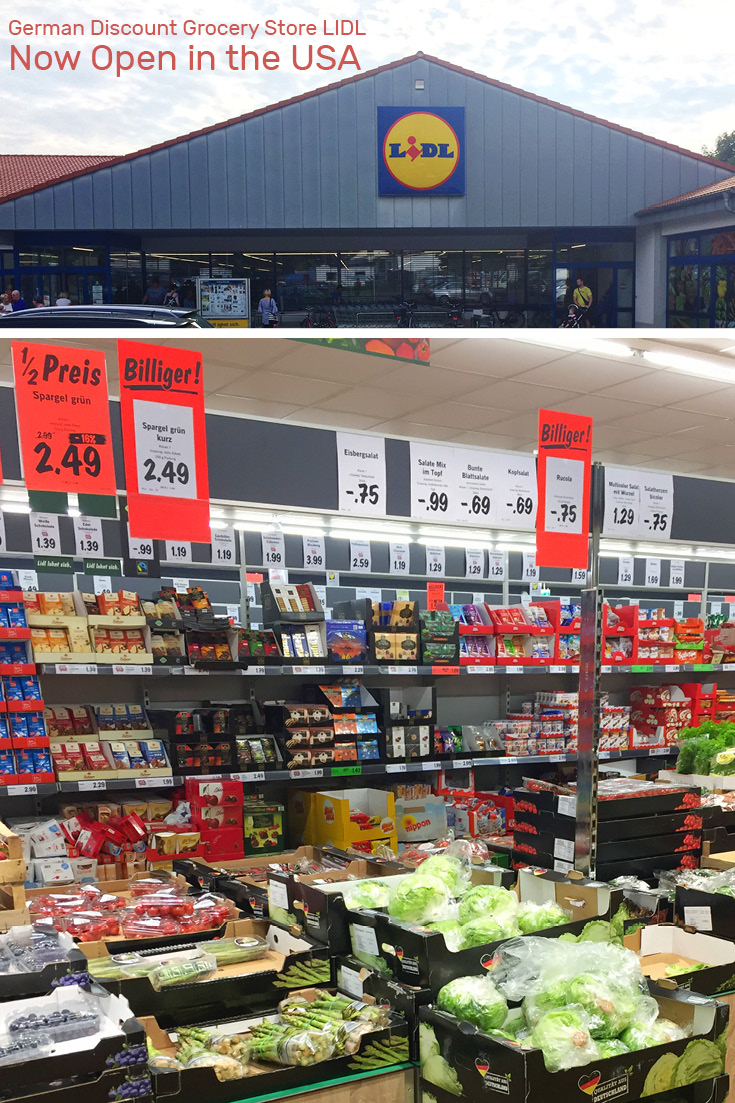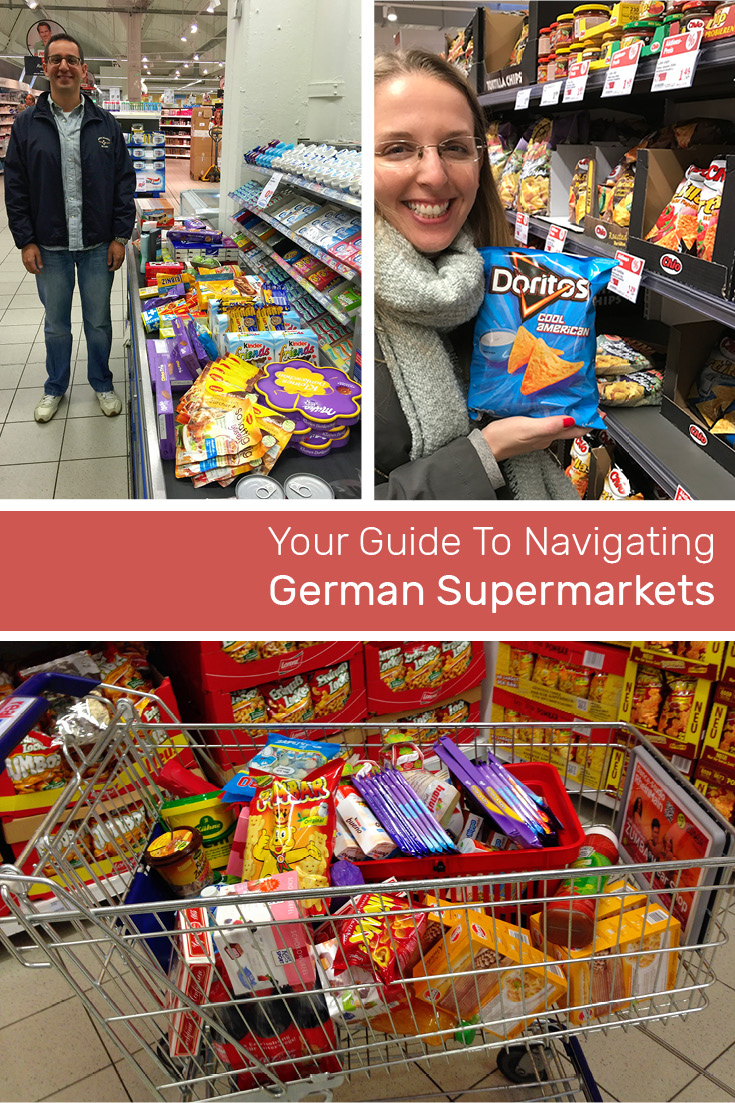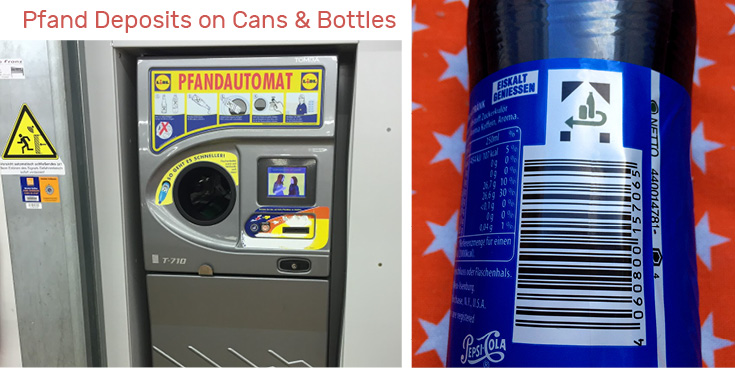Disclosure: Please note that some links are affiliate links, and at no additional cost to you, we earn a commission if you make a purchase.
If you would like to support this website in some way, using these links will help do exactly that.

While some American grocery stores are filing bankruptcy and closing for good, German grocery stores ALDI, and recently LIDL are trying to fill the void with their low-cost concepts. You can now get a “German Shopping Experience” before ever travelling to Germany! Several weeks ago we had our spotlight on ALDI, the German discount grocery store. Here is a link in case you missed it.
At the time of this article ALDI has over 1,600 stores in the United States and is still growing. Another German discounter named LIDL wants to be part of this too and is expected to open its first 150 stores by 2018 in the United States.
The first 9 LIDL stores in the United States opened a few days ago on June 15, 2017. Is one of them near you? Here they are:
North Carolina: Greenville, Kinston, Rocky Mount, Sanford, Winston-Salem
South Carolina: Greenville, Spartanburg
Virginia: Hampton, Virginia Beach
More stores are coming to Delaware, Georgia, Maryland, New Jersey and Pennsylvania in 2017 and 2018.
ALDI and LIDL are both considered “discount stores”, which only stock about 1,000 products on their shelves. This low inventory means, that you will only find one package of sliced Swiss cheese, but at a lower price point. About 90% of the products sold are their own brands, which enables these discount stores to sell items at a lower price point and pass the savings on to the consumer. Also, a lot of the products are pushed into the store on pallets, which saves time compared to setting them on shelves and, again, saves the discount stores money by having less staff.
For more reading on LIDL coming to the United States, read the story by Nandita Bose for Reuters, "Germany's Lidl to price groceries up to 50 percent below U.S. rivals," or visit LIDL'S Home page.
Follow Along
If you enjoyed this article, or these topics sound interesting to you, you'll love our weekly newsletter. You'll receive the newest posts each week and exclusive access to free planning resources like ‘Packing List & Tips for 2 Weeks in Germany’ and ‘Everything You Need to Rent a Car in Germany’.
Thank you for reading!


A grocery store is a grocery store, whether it is located in the United States or Germany. Yes, grocery stores in both countries sell fresh produce, bread, milk and other essentials. However, there are small differences to keep in mind before you start your shopping trip. The most convenient feature, to me is that the price that is on the tag is the final price you pay. It already includes the tax, so if you see a package of strawberries for €3.00, this will be the price you will pay at the register. Here are more helpful hints for your grocery store trip in Germany:
Why are Eggs Not Chilled?
In Germany, eggs are stored on ordinary shelves, while they are refrigerated in the United States. The simple reason: freshly laid eggs in the United States are washed for hygienic reasons before they arrive at grocery stores for sale. It is forbidden to sell eggs, that have not been washed with hot water and odorless soap in order to be germ free. In Germany it is exactly the other way round: Washed eggs are prohibited to be sold. During the washing process the natural protective layer is lost. This layer prevents bacteria and salmonella from getting into the interior of the egg. Once the protection has been washed off, eggs have to be kept in coolers.
Bring Your Own Bags
Before you head out to the store, know this: there are usually no free bags given out by German grocery stores. Germans tend to bring their own bags or folding crates (like these at The Container Store), and even pack their items themselves. If you forget your bags, you can purchase bags at the checkout register. Also, there are no packers at the end of the conveyor belt. Wal-Mart failed when they tried to introduce bagging groceries for customers in the 1990s Germany. (For more on Wal-marts in Germany, check out this article from the Huffington Post).
Store Hours & Sundays
Most grocery stores in Germany are open from 7am until 8pm. Some larger chains stay open longer, but all of them have one thing in common: closed on Sundays. This day of the week is reserved for relaxing, dining together with your family, or heading to a museum. For emergency runs on a Sunday, look for gas stations or supermarkets in a train station or at an airport. If that is too far for you, check if you can borrow some milk for your Sunday morning cereal from your neighbor.
Grocery Cart Deposits
It is very common to drive onto a grocery store parking lot in the United States and see carts scattered from customers being too lazy to return the cart to a corral. Germans came up with their own way of dealing with this. To get a grocery cart in Germany, you have to insert a €0.50 cent or €1 coin into the handle in order to release the cart. Use it for shopping in the store and later return it the same place you received it. Insert the metal plug into the back of the handle and get your coin back. This saves grocery store employees from having to collect carts and gives you some exercise.
Why is the Milk Not Being Refrigerated?
The United States had fresh milk deliveries by a milkman for decades. The milkman stopped by several days a week, took the empty milk bottles and left fresh bottles of milk at the doorstep. This milk has to be refrigerated, since it is “only” pasteurized, meaning it is heated up to about 160 degrees Fahrenheit and will be good for about 2 to 3 weeks in the fridge. Contrary to that, more than 65% of the milk in Germany is treated with Ultra-high temperature processing at 275 degrees Fahrenheit, which basically sterilizes the milk. This kind of milk can be sold non-refrigerated and has a shelf life of 6 to 9 months. You can also buy some milk from the refrigerated section in a Germany supermarket in case you want to do a taste test and compare a pasteurized and a ultra-high heated milk.

Pfand Deposits on Cans & Bottles
To promote recycling, in 2003 the ever-clever, thrifty Germans implemented a container deposit legislation, also known as Pfand [pronounced pf‿ant]. If you buy a single-use container in form of a can of soda or a water in a plastic bottle, you will pay a €0.25 deposit, which will be refunded when you bring the container back to a supermarket or shop. Sometimes a real person will refund your deposit, sometimes you have to push your bottle or can into one of these deposit return machine and get a voucher printed. Either use the voucher in the store or go to the cash register to have the amount paid out to you in cash. When you throw that bottle away, you're also throwing away your €0.25. The deposit legislation does not cover containers for juice, milk-products, wine, spirits, or liquors.
Did we forget other differences that you have noticed? Let us know in the comments!
Follow Along
If you enjoyed this article, or these topics sound interesting to you, you'll love our weekly newsletter. You'll receive a free Germany Packing list for signing up, and you'll receive each week's newest posts every Friday. Thank you for reading!

The success story of ALDI started in the spring of 1913, when the baker Karl Albrecht, together with his wife Anna, opened “Albrecht” in Essen, Germany. At that time, self-service was still quite unusual and all customers were personally served by the store clerks. This is what the first storefront looked like:
After WWII, their sons Karl and Theo took over the store in 1945 and and expanded their family business into 100 branch stores by 1955 and over 300 by 1960. The ALDI brothers Karl and Theo are considered the inventors of the discount supermarket system in Germany and were among the richest people in the world, each valued at just under 20 billion dollars by Forbes magazine. However, both valued their privacy and declined most interviews, hence there are very few photos of the two brothers. Theo Albrecht died in 2010 due to a severe fall, and Karl passed away in 2014. Here is one of the few photos, from WirtschaftsWoche's archive:
A Disagreement About Cigarettes
The growth of the Albrecht store empire went well until 1960, when the brothers divided the company into two geographical areas in Germany: ALDI North and ALDI South. Apparently they had a clash of opinions regarding the sale of cigarettes. The northern branches were taken over by Theo, who was the one that wanted to sell cigarettes and and the southern branches were managed by Karl Albrecht (ALDI South sells cigarettes only since 2003).
Times are Changing
Also in the early 1960’s, Germans started to discover supermarkets how we know them today, where you can walk in, grab what you need, pay and leave. The small service stores like the ones from the Albrecht brothers saw a decline in sales and the brothers decided in 1961 to open their own chain of supermarkets. They chose the name ALDI (ALbrecht DIscount) for their new supermarket-style stores. Their concept for their new stores was a bit different than the one of a traditional supermarket. The ALDI stores offered no duplicates of food, so for example there was only one type of orange instead of several kinds to choose from. The basic idea is to only have products in the assortment which have a high turnover rate, about 700 items per store.
ALDI is focused on staple food items and did not issue price tags on each item until the early 1990s. I still remember being at ALDI with my mother and the cashiers would manually enter each price for each item with the prices they had memorized. If they were not sure, they would ask the next cashier over, who would then yell back with the exact price. The ALDI brothers also negotiated products with well-known manufacturers, which were produced under a different name specially for ALDI. As a result, these products were not subject to price constraints and advertising costs, enabling ALDI stores to sell them favorably.
ALDI Today
To this day ALDI stores are rather simple when it comes to decoration and advertisements. Most items are sold directly out of the manufacturers shipping carton and all shelves carry the same orange price sticker. All employees are cross-trained to be at the cash register or re-stock items that are running low. This omission of “traditional” supermarket retail features brought the ALDI supermarkets great cost advantages over the years, at the same time enabling consumers great price advantages. Until the 1980s, ALDI had the image of a “poor people's” supermarket. Their products were regarded as qualitatively sufficient, but without prestige. Even today, poor populations are an important target group for ALDI, however many of the products marketed by ALDI have very good test results in German Consumer Reports magazines.
An important image change for ALDI came during the 1990’s, when they started their short-term weekly offers, usually as part of a theme week, for example handyman items with an assortment power drills, saws and work boots. During my high school years and the rise of personal computers, ALDI even offered the first "ALDI PC" around Christmas 1995, right when the internet started taking off and everybody got an AOL CD in the mail every other week. It was a well-equipped machine, that sold out in the first hours of the sale, based on its fair price and the fact that the German computer market was unsaturated with computers. This is a picture of the first PC’s being sold by ALDI, photo courtesy of Lebensmittel Zeitung:
2 Tips When Shopping at ALDI
Two things to keep in mind before you visit ALDI for your first time either in Germany or in the States: Customers are expected to bring their own bags from home to transport their groceries, otherwise they can purchase bags at the store for a small fee. That way ALDI cuts down on the use of plastic bags, which is good for the environment and good for their expenses.
Secondly, expect to pay a deposit if you want to use a shopping cart. Another way ALDI saves, is that customers pay a 1 Euro deposit to use a shopping cart at ALDI. "The shopping cart rental system is one of many ALDI efficiencies that enable us to keep our prices so low," the company informs on its website. "By not having to hire someone to police the shopping carts, we are able to pass the savings onto our customers." In the USA the deposit is typically a quarter.
You can see their current sales ad here.
Have you been to an ALDI store already? What do you think about them? Let us know in the comments.
Follow Along
If you enjoyed this article, or these topics sound interesting to you, you'll love our weekly newsletter. You'll receive a free Germany Packing list for signing up, and you'll receive each week's newest posts every Friday. Thank you for reading!

